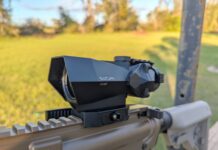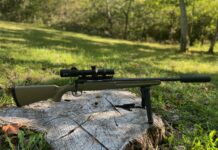One of the most current heated topics (no pun intended) among many night hunters worldwide is optics choice. There are multiple factors to consider in determining the right scope for you. What type of game you’re hunting, where and in what conditions will the scope be used and price range are just a few of the things to consider before determining if you should go night vision or thermal.
Both night vision and thermal optics assist hunters in detecting, recognizing and identifying targeted animals. But they also both have their pros and cons, so it’s important to understand the differences in the technology before making your decision.
THERMAL
Thermal optics detect radiation or heat. The higher the temperature, the more radiation something gives off. Since thermal detects radiation, it does not require any visible light to provide an image of your target. You are able to make out even small animals in deep cover or when concealed by fog which is one great advantage.
On the flip side of that, though, is since you’re looking at a thermal image, you will have less detail. This imposes the problem of not always being able to determine what type of animal you are looking at right away, especially from longer distances, therefore also making it more difficult to determine proper shot placement.
Thermal scopes also tend to be heavier than night vision scopes and handling your weapon may take some getting used to. When it comes to pricing, thermal is definitely on the higher side since it’s newer and costlier to manufacture.
NIGHT VISION
Unlike thermal, night vision requires a light source to provide an image. In many cases, the stars and moon will provide enough light to produce an image, but shadows can make it more difficult to see. Modern night vision optics come equipped with an IR illuminator which can make images a lot clearer and more detailed.
The IR illuminator works like a flash light, but isn’t visible to the naked eye. Night vision images tend to be a lot more detailed and natural than thermal. Night vision is only problematic if the game is camouflaged or standing still. The technology has been around a lot longer as well and is more rugged and more readily absorbs recoil.
Before making up your mind which is best for you, you should ask yourself these questions:
- ENVIRONMENT
- Knowing what conditions you will be hunting in is crucial. Will you be in thick brush or an area where fog is often a problem? Thermal imaging can detect an animal in deep cover or hidden by fog easier, so it would be a better choice for these conditions.
- Are you hunting in an area where the temperature can be freezing, or you keep the windows closed in your blind? Extreme cold can affect the quality of a thermal image and thermal optics aren’t capable of seeing through glass, so night vision is a better choice.
- PRICE
- Cost is usually a determining factor for most people. On average, a quality night vision scope is roughly a quarter of the price of a thermal scope. Not to mention the additional features like color thermal which can bring the price up even higher.
- Usually, either scope can record, but you have to ask yourself if you want to be able to record directly with an SD card, a cord from your scope to your camera or if the scope has built-in wi-fi capabilities (like the Accufire Noctis V1 digital night vision scope). How easy is it to zoom in and out? Will the scope you want work with the rails on your AR? All of these are important questions which can drive up the price of your purchase.
This post originally appeared at accufiretech.com and is reprinted here with permission.





Simple. The difference is the same as sex vs masturbation. While both are fun and rewarding, only one is the real thing and you want to do it all the time!! Hint…. it’s the thermal
For single guys, one is *vastly* cheaper than the other… 😉
There is a difference?
Not my experience at all. I’ve found thermal useful for scanning, but that’s about it. Thermal just doesn’t have the detail I want to make a shot at distance that will put the pig down so I don’t end up having to try and track it at night. I scan with thermal, but put lead on pigs with traditional NV.
Fog is bunch of water droplets in the air that can block a persons ability to see past a point, how/why does the thermal not see the fog?
“how/why does the thermal not see the fog?”
Infared light is relatively long-wavelength light. Fog is relatively ‘transparent’ to IR ‘light’.
This is why we are spending *billions* of dollars on building and soon flying the ‘James Webb Space Telescope’, to detect infrared light and ‘see through’ thick bands of dust in our galaxy.
A very practical use of a thermal vision device in an aircraft is something known as ‘Forward-looking infrared’ or, (FLIR).
It can ‘see through’ fog allowing flying and safer landings in foggy or duststorm conditions. I’ve seen a demonstration of the technology at an aviation gathering. It was impressive…
Thanks, Geoff.
I know that Aviat has a FLIR option for the Husky. And now you order a FLIR camera to install in a home-built plane that will work with a MFD.
It’s seriously neat technology.
That along with being able to overlay on an MFD weather radar on a moving-map GPS is saving lives.
The Aviat you saw, was that the yellow one with the full Garmin glass panel front and rear in it?
I never saw it, I just read about the press release and on the website. Front and back seat panels, wow, I didn’t know about that one.
Its been a while back, but the AN-TAS thermal of the TOW IIB damn sure was degraded by fog. Range dependent and the TOW envelope was 3850m, perhaps your popgun is less capable.
. Possum see in dark. Device of night vision need not
True, but until human augmentation gets well and truly underway (probably 20-30 years out; that’s gonna be the next major technological leap for humanity in much the same way the internet has been) we’ve gotta rely on technology to overcome our biological limitations.
I’ve been saying it since 87′. God I wish i could see like the PREDATOR!
Some of you night hunt with some serious weaponry. I don’t think hog hunting with tow missiles is legal even in Texas.
I believe the in this State its legal until you get caught.
This comment is uncomfortably close to everything fun in my state.
Comments are closed.